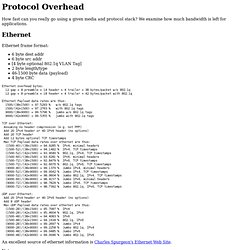

Speedtest. IP Packet Overhead. By Richard Hay What does it cost for transport?

This question can be applied to moving goods and delivering services across distances. King Hussein of flew to so he could have his heart operation performed at Johns Hopkins. People will pay to ship expensive Ferrari Enzo super sports cars from to . Similarly, there are costs associated with transporting IP packets. Let me tell a true story about the first time I realized lower layer overhead matters and makes a difference in performance results. Once upon a time I was a test engineer for a Tier 1 IP Service provider. Figure I. When I ran the tests I had some of the oddest results I had ever encountered. As this book will explain, a 46 byte IP packet inside of a 64 byte Ethernet frame actually utilizes at least 84 bytes on the Ethernet wire. How does anyone come into a situation where knowing the per packet layer1 & layer2 overhead conditions for various technologies even matters you may ask?
1.1 Packets/Sec & Bits/Sec Figure II. Protocol Overhead. How fast can you really go using a given media and protocol stack?

We examine how much bandwidth is left for applications. Ethernet Ethernet frame format: 6 byte dest addr 6 byte src addr [4 byte optional 802.1q VLAN Tag] 2 byte length/type 46-1500 byte data (payload) 4 byte CRC An excellent source of ethernet information is Charles Spurgeon's Ethernet Web Site. Notes: 48-bit (6 byte) ethernet address have a 24-bit "Organizationally Unique Identifier" (OUI) assigned by IEEE + a 24-bit number assigned by the vendor. Gigabit Ethernet with Jumbo Frames Gigabit ethernet is exactly 10 times faster than 100 Mbps ethernet, so for standard 1500 byte frames, the numbers above all apply, multiplied by 10 (for 10GE, multiple by 100).
An excellent paper on ATM overhead was written by John Cavanaugh of MSC. Notes: DS3 and SONET frames are 125 usec long (8000/sec). On the physical layer (single pt-to-pt hop), one out of every 27 cells is an OAM cell. Packet Over SONET (POS) So we get: References: P. Thinking about QoS for IP/MPLS Networks - Backbone Infrastructure - Latency Versus Link Utilization. Latency Versus Link Utilization Queuing delay increases rapidly as the link utilization gets closer to 100 percent.

Intuitively, congestion should not arise as long as the link utilization remains below 100 percent. In reality, the rate at which packets reach an output interface varies significantly over time, and some level of congestion will take place even when the average utilization is well below 100 percent. Figure illustrates this relationship. This figure uses normalized latency time units and assumes random packet arrivals according to a Poisson distribution.
Congestion Latency as a Function of Link Utilization In the past decade, many studies have questioned the validity of the Poisson assumption and have suggested that packet-switched traffic exhibits self-similar behavior. Poisson Traffic Pattern. Will the Web have a place in a world full of apps? - By Farhad Manjoo. Last summer, in a much-read cover story, Wired proclaimed that the Web is dead.

Chris Anderson, the magazine's editor, argued that loading pages in a browser is passé. The future, Anderson wrote, is in downloadable apps, which have several advantages over the Web. They're fast, they can be customized for specific purposes, and—perhaps most importantly—people seem to have no problem paying for them, which means that software and media companies have an incentive to keep creating more. Few of us, meanwhile, pay for Web content—and our reluctance, Anderson argued, spoke volumes about what we really want from our computers: "Much as we love freedom and choice, we also love things that just work, reliably and seamlessly. " Farhad Manjoo is a technology columnist for the Wall Street Journal and the author of True Enough.
Follow But as I began to think about how the Internet will evolve—for this, the second article in my series on the future of tech—I found myself splitting the difference. Is your network ready to handle videoconferencing? Videoconferencing helps reduce travel expenses and decreases carbon footprints, while also creating a highly productive work environment.

This creates a compelling return on investment (ROI), but without a supportive network environment, the investments and potential cost savings are put at risk. As IT budgets shrink and sensitivity to travel costs grows, recent improvements in videoconferencing have made the technology a logical consideration for many companies. Videoconferencing helps reduce travel expenses and decreases carbon footprints, while also creating a highly productive work environment. These benefits create a compelling return on investment (ROI), but if organizations do not have the foresight to power their videoconferencing technology with a supportive network environment, they put their investments and potential cost savings at risk.
The ROI of videoconferencing Figure A Saving money sounds good: What next? Performance metrics: The affects of jitter, packet loss, and latency. Multipoint Video Conferencing. OmniJoin™ Web and Video Conferencing is a business-grade, secure online meeting service.

All web, VoIP, and video conferencing data is transmitted over encrypted connections, end-to-end. OmniJoin™ conferencing was designed for security conscious customers, IT policy compliance, and multi-office networks. For more information about our security features, please read the material below or Contact Us to schedule a Q&A session. Business-Grade Online Meetings OmniJoin™ cloud-based resources are located in secure facilities with restricted physical access End-to-end encryption provides transmission security and all online meeting Hosts are authenticated All OmniJoin™ software and online services use signed code with a third-party certificate for all downloadable software components Additional access, user, and feature controls are provided in the OmniJoin™ administrative console such as requiring meeting passwords, disabling remote control, and more.